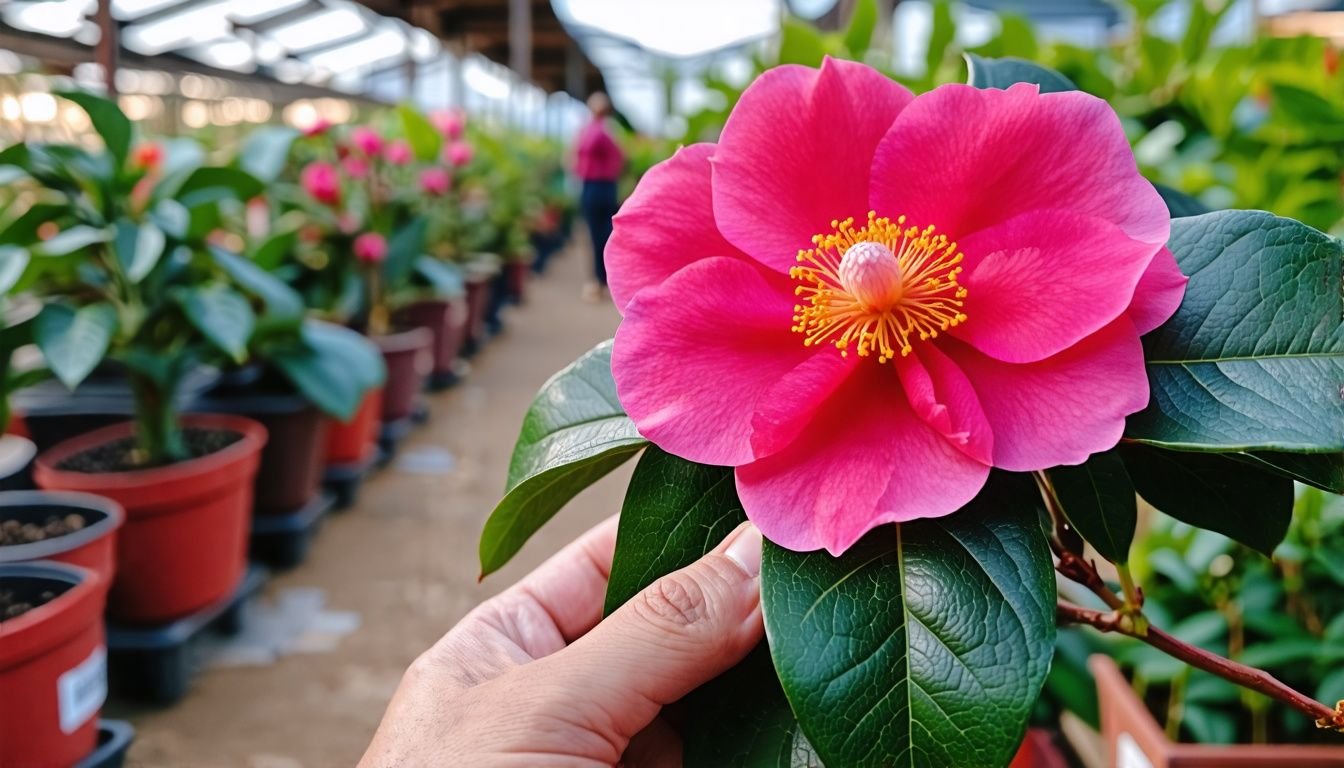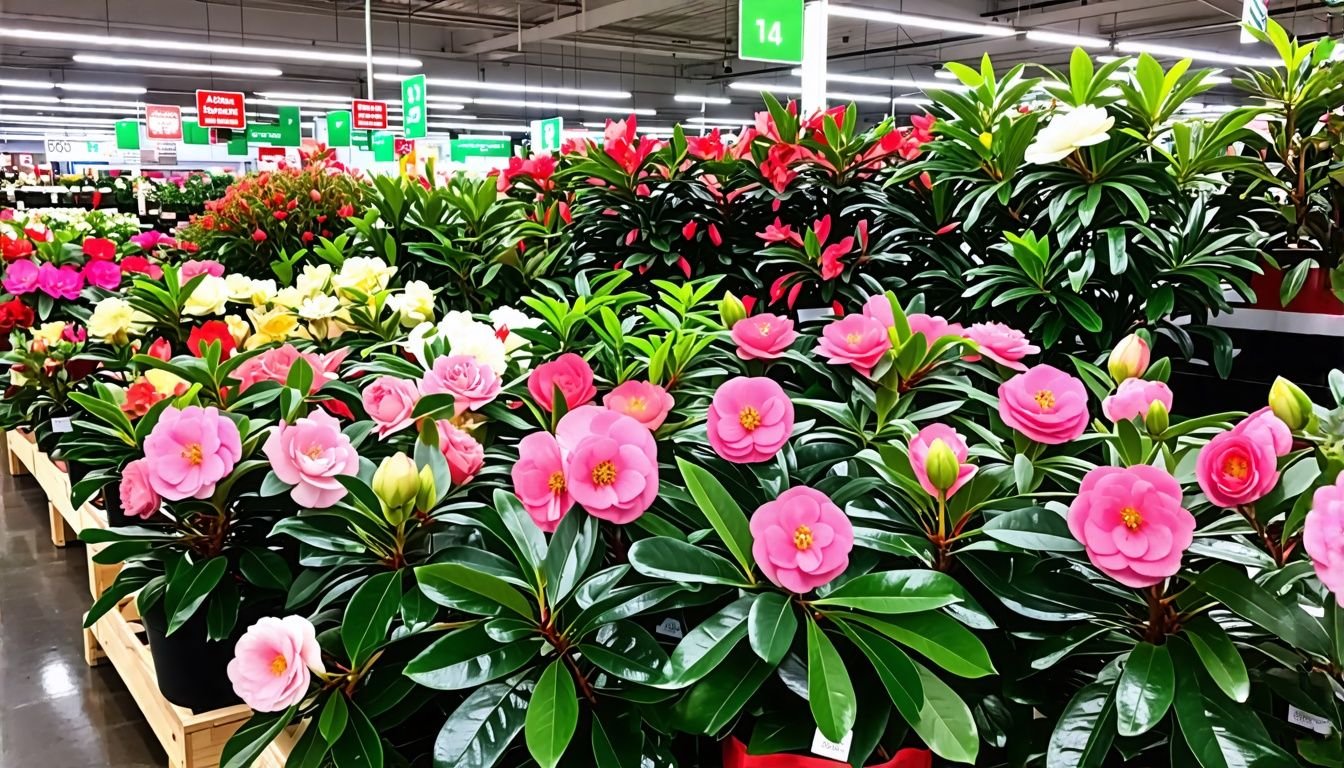G’day, plant lovers! Fancy adding some stunning blooms to your Aussie garden? Camellias might be just the ticket. But let’s be honest, growing these beauties can be a bit of a challenge.
Many of us have struggled with getting our camellias to thrive, facing issues like yellowing leaves, sparse flowers, or plants that just won’t grow.
We’ve all been there, haven’t we? Scratching our heads in the garden, wondering what we’re doing wrong. That’s why we’ve done our homework and had a yarn with the experts at Bunnings to bring you this complete guide.
Here’s a fun fact for you – did you know that camellias can live for over 100 years with proper care? Crikey!
We’ll show you how to select, plant, and care for camellias in our unique Aussie conditions. From choosing the right spot to pruning tips, we’ve got your back. So, are you ready to give your garden a fair dinkum transformation? Let’s get cracking, mate!
Key Takeaways
- Bunnings offers two main camellia types: Camellia sasanqua and Camellia japonica, both suited for Aussie gardens.
- Plant camellias in autumn or spring in partial shade to full sun, spacing them 1-2 metres apart for good air flow.
- Camellias need well-drained, acidic soil with a pH of 6.0-6.5 and regular watering without waterlogging.
- Feed camellias with slow-release fertiliser in early spring and prune lightly after flowering to maintain shape.
- With proper care, camellias can live over 100 years, providing long-lasting beauty to Australian gardens.
Selecting the Right Camellia for Your Garden

Choosing the perfect camellia for your garden can be exciting. We offer two main types at Bunnings: Camellia sasanqua and Camellia japonica.
Camellia sasanqua
Camellia sasanqua is a star in Australian gardens. We love this flowering shrub for its beauty and adaptability. It thrives in partial shade to full sun, making it perfect for various spots in your yard.
The evergreen foliage stays lush all year, while the blooms add bursts of colour.
We recommend planting Camellia sasanqua in autumn or spring. This timing gives the roots time to settle before extreme weather hits. The plant prefers well-drained, acidic soil rich in organic matter.
We suggest spacing them one to two metres apart. This gap ensures good air flow, which keeps the plants healthy.
Camellia sasanqua: Nature’s gift of year-round beauty to Australian gardens.
Let’s explore how to select the right Camellia for your garden next.
Camellia japonica
We love Camellia japonica for its stunning flowers and long blooming season. This popular variety thrives in Australian gardens, bringing beauty and charm. At Bunnings, we offer a range of these lovely plants to suit different garden styles.
Planting Camellia japonica requires some care. We recommend putting them in during spring or autumn for the best results. They prefer spots with partial shade, which protects them from harsh afternoon sun.
The soil should be moist and well-drained, with a pH between 6.0 and 6.5. This slightly acidic to neutral range helps the plants flourish.
To keep your Camellia japonica healthy, give them space. We suggest planting them one to two metres apart. This spacing allows for good air flow, which is key for plant health. With the right care, these beauties will reward you with a stunning display of flowers year after year.
Planting and Positioning Camellias
Camellias thrive in the right spot. We’ll guide you on where to plant these beauties for the best results.
Sunlight and shade requirements
We love how camellias thrive in spots with partial shade to full sun. These beauties need protection from harsh afternoon rays, especially for young plants. In cooler Aussie climates, camellias flourish best.
We shield new shrubs from frost and extreme weather to give them a strong start.
Different camellia types have unique light needs. Camellia sasanqua enjoys areas with partial shade to full sun. Its cousin, Camellia japonica, prefers partial shade to stay safe from intense afternoon heat.
We pick the right spot in our gardens to help these stunning flowers bloom their best.
Soil preparation and planting depth
After considering sunlight and shade, we must focus on soil preparation and planting depth for our camellias. These plants thrive in well-drained, acidic soil rich in organic matter.
We aim for a pH between 6.0 and 6.5, which is slightly acidic to neutral. To achieve this, we mix compost or well-rotted manure into the existing soil.
Proper drainage is crucial for camellia health. We create raised beds or mounds if our garden has heavy clay soil. This prevents waterlogging, which can harm camellia roots. When planting, we dig a hole twice as wide as the root ball and just as deep.
We place the camellia at the same depth it was in its pot. Planting too deep can lead to root rot.
Spacing is another key factor for camellia growth. We plant our camellias one to two metres apart. This allows for good air circulation, reducing the risk of fungal diseases. After planting, we add a layer of organic mulch around the base.
This helps retain moisture and suppress weeds. With these steps, we set our camellias up for healthy growth in our Australian gardens.
Maintenance Tips for Healthy Camellias
Camellias need regular care to stay healthy and bloom well. We’ll show you how to water, feed, and prune your camellias for the best results.
Watering and feeding
We know that proper watering and feeding are crucial for healthy camellias. Our plants need consistent moisture, but we must avoid waterlogging the soil. A good rule is to check the soil regularly and water when it feels slightly dry.
We use mulch around our camellias to help retain moisture and keep weeds at bay.
Feeding our camellias is just as important as watering. We apply a slow-release fertiliser made for camellias in early spring, just before new growth starts. This gives our plants the nutrients they need to thrive throughout the growing season.
During dry spells, we pay extra attention to watering, making sure our camellias don’t get thirsty.
A well-fed and watered camellia is a happy camellia.
Pruning techniques
Pruning camellias keeps them healthy and looking their best. We trim our plants lightly after they flower to maintain their shape. This also lets us remove any dead or diseased branches.
It’s crucial not to prune too heavily, as camellias bloom on old wood. Regular checks help us spot and treat any pest issues early.
Good air flow around our camellias is vital for their health. We ensure this by careful pruning and spacing. For young plants, we take extra care to shield them from frost and harsh weather.
These steps help our camellias thrive and produce beautiful blooms year after year. Next, let’s explore the best watering and feeding practices for camellias.
Conclusion
We’ve looked into camellias at Bunnings and how to grow them in Australian gardens. These stunning shrubs offer beauty and versatility for any outdoor space. With the right care, your camellias will thrive and bloom year after year.
Choose the best variety for your climate, plant in the right spot, and maintain them properly. Your efforts will reward you with a gorgeous display of flowers that will make your garden the envy of the neighbourhood.
FAQs
1. What are the best conditions for growing camellias in Australian gardens?
Camellias thrive in well-drained, acidic soil with partial shade. They prefer protection from harsh afternoon sun and strong winds. Australian gardeners should aim for a pH between 5.5 and 6.5 for optimal growth. Regular watering and mulching help maintain soil moisture and temperature.
2. How often should I fertilise my camellia plants?
Feed camellias twice a year with a slow-release fertiliser designed for acid-loving plants. Apply in early spring before new growth starts and again in late summer after flowering. Avoid over-fertilising, as this can lead to leaf burn and poor flower production.
3. What are common pests and diseases affecting camellias in Australia?
Scale insects, spider mites, and aphids can infest camellias. Diseases like petal blight and root rot may occur in humid conditions. Regular inspection and proper plant care are crucial. Use appropriate pesticides or organic treatments if problems arise. Ensure good air circulation to prevent fungal issues.
4. How do I prune camellias to maintain their shape and encourage blooming?
Prune camellias after flowering but before new growth begins. Remove dead or crossing branches to improve air circulation. Shape the plant by cutting back long stems. Avoid heavy pruning, as camellias bloom on old wood. Light trimming promotes bushier growth and more flowers in the following season.
